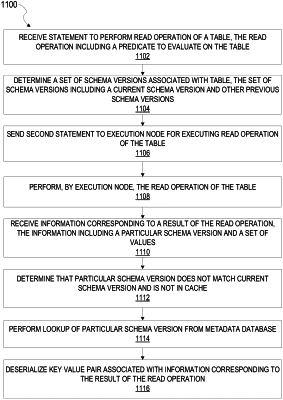| CPC G06F 16/213 (2019.01) [G06F 16/221 (2019.01)] | 27 Claims |

|
1. A system comprising:
at least one hardware processor; and
a memory storing instructions that cause the at least one hardware processor to perform operations comprising:
generating, by a compute service manager, a schema hash value for a new schema version associated with a new schema version value, the schema hash value based on determining a sum of hash values of a set of attributes of value columns, the set of attributes comprises a column identifier, and a logical type of a column;
storing a mapping of the schema hash value to the new schema version value for a table in a metadata database;
storing a new schema entry based on the schema hash value, the new schema version value, and a new column for the table in the metadata database, the metadata database storing multiple entries for different schema versions, each entry including a particular schema hash value for mapping to a corresponding schema version from the different schema versions;
receiving a first statement to perform a read operation of a particular table, the read operation including a predicate to evaluate on the particular table;
sending a second statement to an execution node for executing the read operation of the particular table;
receiving information corresponding to a result of the read operation, the information including a particular schema version and a set of values;
determining that the particular schema version does not match a current schema version and is not in a cache;
performing a lookup of the particular schema version from the metadata database; and
deserializing a key value pair associated with information corresponding to the result of the read operation.
|